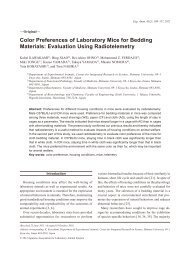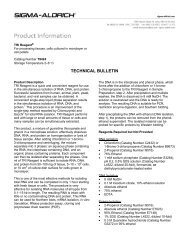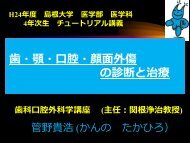MISSION Lentiviral Packaging Mix (SHP001) - Technical Bulletin
MISSION Lentiviral Packaging Mix (SHP001) - Technical Bulletin
MISSION Lentiviral Packaging Mix (SHP001) - Technical Bulletin
You also want an ePaper? Increase the reach of your titles
YUMPU automatically turns print PDFs into web optimized ePapers that Google loves.
<strong>MISSION</strong> ® <strong>Lentiviral</strong> <strong>Packaging</strong> <strong>Mix</strong><br />
Catalog Number <strong>SHP001</strong><br />
Storage Temperature −20 °C<br />
TECHNICAL BULLETIN<br />
Product Description<br />
The <strong>MISSION</strong> <strong>Lentiviral</strong> <strong>Packaging</strong> <strong>Mix</strong> is an optimized<br />
formulation of two plasmids expressing the key HIV<br />
packaging genes and a heterologous viral envelope<br />
gene.<br />
<strong>MISSION</strong> lentiviral particles are generated from three<br />
main components:<br />
1. The packaging vector, which contains the minimal<br />
set of lentiviral genes required to generate the<br />
virion structural proteins and packaging functions<br />
2. The vesicular stomatitis virus G-protein (pCMV-<br />
VSV-G) envelope vector, which provides the<br />
heterologous envelope for pseudo-typing<br />
3. The shRNA transfer vector, which contains the<br />
sequence of interest as well as the cis acting<br />
sequences necessary for RNA production and<br />
packaging.<br />
The <strong>Lentiviral</strong> <strong>Packaging</strong> <strong>Mix</strong> contains the first two<br />
components; it is designed to be co-transfected along<br />
with a compatible lentiviral transfer vector in order to<br />
create high-titer pseudo-typed lentiviral particles used<br />
for downstream transduction applications.<br />
The <strong>MISSION</strong> shRNA product line is centered on a<br />
transfer vector-based RNAi library against annotated<br />
mouse and human genes that can be used in<br />
conjunction with this <strong>Lentiviral</strong> <strong>Packaging</strong> <strong>Mix</strong>. In this<br />
packaging system, the pseudo-typing with VSV-G<br />
broadens the viral tropism associated with the virus. 1<br />
Therefore, these lentiviral particles can efficiently<br />
deliver the transfer sequence of interest to a wide<br />
variety of cell types, including primary and non-dividing<br />
cells. 2, 3<br />
The particles are produced using a third-generation<br />
packaging system, which has many features that lead<br />
to enhanced biosafety. 4 Some of these features are<br />
described in Table 1.<br />
Table 1.<br />
Biosafety Features of the Third-Generation<br />
<strong>Lentiviral</strong> <strong>Packaging</strong> System<br />
Feature<br />
Multi-plasmid<br />
approach<br />
Deletion in U3<br />
portion of 3’ LTR<br />
which eliminates<br />
the promoterenhancer<br />
region<br />
Elimination of the<br />
majority of<br />
lentiviral genes<br />
(∆ vpr, vif, vpu<br />
and nef) 5<br />
Result<br />
No single plasmid contains all the<br />
genes necessary to produce<br />
packaged lentivirus.<br />
Resultant particles are replicationincompetent<br />
Avoids promoter interference<br />
issues and further negates the<br />
possibility of viral replication<br />
Removes virulence genes which<br />
are not necessary for shRNA<br />
packaging systems<br />
The <strong>MISSION</strong> <strong>Lentiviral</strong> <strong>Packaging</strong> <strong>Mix</strong> and the<br />
lentiviral shRNA transfer vectors can be easily<br />
co-transfected into a mammalian production cell line.<br />
We recommend HEK293T cells, ATCC ® Number<br />
CRL-11268, as they are readily transfected and have<br />
been demonstrated to consistently produce a high titer<br />
of virus. 6<br />
Recombinant lentiviruses produced with the <strong>MISSION</strong><br />
<strong>Lentiviral</strong> <strong>Packaging</strong> <strong>Mix</strong> have not been shown to<br />
produce replication competent viral particles because<br />
of designed safety features. Users should consult and<br />
observe their own institutional guidelines for working<br />
with such viral systems.
2<br />
Reagents<br />
<strong>Lentiviral</strong> <strong>Packaging</strong> <strong>Mix</strong>,<br />
Catalog Number <strong>SHP001</strong><br />
0.25 or 1.7 ml<br />
Reagents and equipment required, but not<br />
provided<br />
• <strong>Lentiviral</strong>-based transfer vector(s).<br />
• FuGENE ® 6 Transfection Reagent, Roche<br />
Diagnostics<br />
• HEK293T producer cells<br />
ATCC Number CRL-11268<br />
• Serum-free DME medium<br />
• DME medium supplemented with 10% fetal bovine<br />
serum and 4 mM L-glutamine.<br />
• HIV-1 p24 Antigen ELISA Kit, ZeptoMetrix,<br />
ZMC Catalog # 0801111<br />
Follow distributor’s instructions for culturing and<br />
maintaining the producer cell line. It is recommended<br />
to use the lowest passage # of cells as possible for<br />
transfection experiments.<br />
Precautions and Disclaimer<br />
This product is for R&D use only, not for drug,<br />
household, or other uses. Though the lentiviral<br />
transduction particles produced are replication<br />
incompetent, it is highly recommended that they be<br />
treated as Risk Group Level 2 (RGL-2) organisms. 7<br />
Follow all published RGL-2 guidelines for handling and<br />
waste decontamination. Also, use extra caution when<br />
packaging lentiviral particles that express shRNAtargeting<br />
genes involved in cell cycle control, e.g.,<br />
tumor suppressor genes.<br />
Storage/Stability<br />
If stored properly, shelf life is 2 years from the date of<br />
shipment. The <strong>Lentiviral</strong> <strong>Packaging</strong> <strong>Mix</strong> should be<br />
stored at –20 °C. Avoid multiple freeze thaw cycles.<br />
Procedure Overview<br />
Day 1 Day 2 Day 3 Day 4 Day 5<br />
Plate<br />
HEK293T<br />
cells<br />
Transfect<br />
cells with<br />
packaging<br />
mix and<br />
transfer<br />
vector<br />
Re-feed<br />
cells<br />
with<br />
fresh<br />
media<br />
First<br />
lentiviral<br />
particle<br />
harvest<br />
Second<br />
lentiviral<br />
particle<br />
harvest;<br />
p24<br />
assay<br />
Procedure<br />
Day 1:<br />
Plate the HEK293T cells in complete DME media,<br />
supplemented with 10% fetal bovine serum and 4 mM<br />
L-glutamine, 24 hours prior to transfection. Cells<br />
should reach 70%-80% confluency the day of<br />
transfection. Recommended cell seeding densities for<br />
different plate formats are outlined in Table 2.<br />
Table 2.<br />
Recommended Cell Densities for Various Formats<br />
Format<br />
Initial number of<br />
Cells Plated<br />
96-well plate 16,000 – 20,000<br />
cells/well<br />
60 mm dish 5 x 10 5 cells/dish 8.0 ml<br />
100 mm dish 1 x 10 6 cells/dish 22 ml<br />
T75 flask 1.8 x 10 6 cells/flask 30 ml<br />
T225 flask 5.4 x 10 6 cells/flask 90 ml<br />
Final Volume<br />
of viral<br />
harvest<br />
(Assumes<br />
two harvests)<br />
200 µL<br />
Day 2:<br />
1. Thaw the vial of <strong>Lentiviral</strong> <strong>Packaging</strong> <strong>Mix</strong> at room<br />
temperature. Once thawed, place on ice.<br />
Preparing Volume (in µL) of <strong>Lentiviral</strong> <strong>Packaging</strong> <strong>Mix</strong><br />
To calculate the amount of <strong>Lentiviral</strong> <strong>Packaging</strong> <strong>Mix</strong><br />
needed for the experiment, refer to Table 3. Prepare<br />
excess volume of <strong>Lentiviral</strong> <strong>Packaging</strong> <strong>Mix</strong> based on<br />
format used, in order to compensate for pipetting error.<br />
2. Within a sterile polypropylene tube(s) add the<br />
calculated volume of <strong>Lentiviral</strong> <strong>Packaging</strong> <strong>Mix</strong> for<br />
each transfection.<br />
3. Keep tube(s) on ice.<br />
Table 3.<br />
Volume of <strong>Lentiviral</strong> <strong>Packaging</strong> <strong>Mix</strong> Required for<br />
Various Formats<br />
Format<br />
<strong>Lentiviral</strong> <strong>Packaging</strong> <strong>Mix</strong><br />
96-well plate<br />
1 µL/well<br />
60 mm dish 10 µL/dish<br />
100 mm dish 26 µL/dish<br />
T75 flask<br />
34 µL/flask<br />
T225 flask<br />
107 µL/flask
3<br />
Preparing Amount (in µg) of Transfer Vector<br />
To calculate the amount of transfer vector needed for<br />
the experiment, refer to Table 4. Prepare excess<br />
amount of transfer vector based on format used, in<br />
order to compensate for pipetting error.<br />
4. Add the calculated volume of transfer vector for<br />
each transfection to the sterile polypropylene<br />
tube(s).<br />
5. Keep tube(s) on ice.<br />
Table 4.<br />
Amount of Transfer Vector Required for Various<br />
Formats<br />
Format<br />
Transfer Vector<br />
96-well plate<br />
0.1 µg/well<br />
60 mm dish 1.0 µg/dish<br />
100 mm dish 2.6 µg/dish<br />
T75 flask<br />
3.4 µg/flask<br />
T225 flask<br />
10.7 µg/flask<br />
Preparing Volume of FuGENE 6 Transfection<br />
Reagent/Serum-Free Media Solution<br />
Note: FuGENE 6 transfection reagent has to be<br />
prepared in combination with serum-free DME medium<br />
To calculate the amount of FuGENE 6 transfection<br />
reagent/serum-free medium, refer to Table 5. Prepare<br />
an excess volume based on format used, in order to<br />
compensate for pipetting error.<br />
Table 5<br />
Volume of DME Serum-free Medium and<br />
FuGENE 6 Transfection Reagent Required for<br />
Various Formats<br />
Format<br />
DME Serumfree<br />
Medium<br />
FuGENE 6<br />
Transfection<br />
Reagent<br />
96-well plate 15 µL/well 0.6 µL/well<br />
60 mm dish 70 µL/dish 6 µL/dish<br />
100 mm dish 182 µL/dish 16 µL/dish<br />
T75 flask 237 µL/flask 21 µL/flask<br />
T225 flask 710 µL/flask 62 µL/flask<br />
6. In a sterile polypropylene tube(s), first add the<br />
calculated amount of DME Serum-Free media.<br />
7. To the media, add the FuGENE 6 transfection<br />
reagent.<br />
Note: Use polypropylene material tube(s) rather<br />
than polystyrene because FuGENE 6 transfection<br />
reagent has a tendency to stick to polystyrene.<br />
8. <strong>Mix</strong> components gently.<br />
Making Transfection Cocktail<br />
Combine all transfection cocktail components together<br />
in one polypropylene vial.<br />
9. Add volume of <strong>Lentiviral</strong> <strong>Packaging</strong> <strong>Mix</strong> per one<br />
sample based on the recommendation in Table 3.<br />
10. Add amount of transfer vector per one sample<br />
based on the recommendation in Table 4<br />
11. Add volume of DME serum-free media/ FuGENE 6<br />
per one sample based on the recommendation in<br />
Table 5.<br />
12. <strong>Mix</strong> gently by pipetting up and down.<br />
13. Incubate transfection cocktail for 15 minutes at<br />
room temperature.<br />
14. Add entire transfection cocktail volume from each<br />
polypropylene well(s), plate(s), dish(es) and<br />
flask(s) to the corresponding well(s), plate(s),<br />
dish(es) and flask(s) containing HEK293T cells.<br />
Day 3<br />
Re-feed with fresh media<br />
15. Pre-warm a sufficient amount of complete media<br />
to 37 °C to be used for feeding of the cells.<br />
16. At 16 hours post-transfection, remove media from<br />
the transfected cells (avoid disturbing cells) and<br />
replace with an equal volume of the pre-warmed<br />
complete media.<br />
17. Add the volume of DME complete media to each<br />
well, dish or flask based on the recommendations<br />
in Table 6.<br />
Table 6<br />
Volume of DME Complete Medium Required for<br />
Various Formats<br />
Format<br />
DME Complete Medium<br />
96-well plate<br />
100 µL/well<br />
60 mm dish 5 ml/dish<br />
100 mm dish 10 ml/dish<br />
T75 flask<br />
15 ml/flask<br />
T225 flask<br />
45 ml/flask<br />
18. Incubate cells in incubator (37 °C and 5% CO 2 ) for<br />
an additional 24 hours.
4<br />
Day 4<br />
First harvest of Viral Particles<br />
19. Pre-warm a sufficient amount of complete media<br />
to be used for feeding of the cells.<br />
20. Between 36-48 hours post-transfection, collect<br />
viral particles by carefully removing the media and<br />
placing it in a collection tube.<br />
The first harvest of viral particles can be stored at<br />
2-8 °C for 24-48 hours. For long-term storage,<br />
freeze at –70 °C.<br />
Note: Multiple freeze thaw cycles of viral particles<br />
may reduce the infectious viral titer by 20-50% per<br />
cycle.<br />
Note: Harvest time points should be optimized<br />
depending upon cell health, passage number, and<br />
media composition at the time of transfection.<br />
21. Add an equal volume of fresh pre-warmed<br />
complete media to cells and incubate for an<br />
additional 24 hours<br />
Day 5<br />
Second harvest of Viral Particles<br />
22. Between 60-72 hours post-transfection collect viral<br />
particles by carefully removing the media (if<br />
desired, pool with first harvest).<br />
The second harvest of viral particles can be stored<br />
at 2-8 °C for 24-48 hours. For long-term storage,<br />
freeze at –70 °C.<br />
Note: Multiple freeze thaw cycles of viral particles<br />
may reduce the infectious viral titer by 20-50% per<br />
cycle.<br />
23. Titer viral particles by performing the HIV p24<br />
Antigen ELISA assay immediately after pooling<br />
(see manufacturer’s protocol).<br />
References<br />
1. Burns, J.C., et al., Vesicular Stomatitis Virus G<br />
Glycoprotein Pseudotyped Retroviral Vectors:<br />
Concentration to a Very High Titer and Efficient<br />
Gene Transfer into Mammalian and Nonmammalian<br />
Cells. Proc. Natl. Acad. Sci. USA, 90,<br />
8033-8037 (1993).<br />
2. Abbas-Terki, T., et al., <strong>Lentiviral</strong>-mediated RNA<br />
interference. Hum. Gene Ther., 13, 2197-2201<br />
(2002).<br />
3. Stewart, S.A., et al., Lentivirus-delivered stable<br />
gene silencing by RNAi in primary cells. RNA, 9,<br />
493-501 (2003).<br />
4. Dull, T., et al., A third generation lentivirus vector<br />
with a conditional packaging system. J. Virol., 72,<br />
8463-8471 (1998).<br />
5. Zufferey, R., et al., Nat. Biotechnol., 15, 871-875<br />
(1997).<br />
6. Pear, W.S., et al., Production of high-titer helperfree<br />
retroviruses by transient transfection. Proc.<br />
Natl. Acad. Sci. USA, 90, 8392-8396 (1993).<br />
7. NIH Guidelines for Research Involving<br />
Recombinant DNA Molecules (NIH Guidelines)<br />
2002 (http://www4.od.nih.gov/oba).<br />
8. Whither RNAi? Nature Cell Biology, 5, 489-490<br />
(2003).<br />
ATCC is a registered trademark of the American Type Culture<br />
Collection.<br />
FuGENE is a registered trademark of Roche Diagnostics<br />
GenElute is a trademark of Sigma-Aldrich Biotechnology<br />
LentiVector is a registered US and European Community trade mark<br />
of Oxford BioMedica plc.<br />
<strong>MISSION</strong> is a trademark of Sigma-Aldrich Biotechnology<br />
TurboGFP is a trademark of Evrogen Co.<br />
Limited Use Licenses<br />
This product is licensed under U.S. Pat. Nos. 5,817,491; 5,591,624;<br />
5,716,832; 6,312,682; 6,669,936; 6,235,522; 6,924,123 and foreign<br />
equivalents from Oxford BioMedica (UK) Ltd., Oxford, UK, and is<br />
provided for use in academic and commercial in vitro and in vivo<br />
research for elucidating gene function, and for validating potential<br />
gene products and pathways for drug discovery and development,<br />
but excludes any use of LentiVector® technology for: creating<br />
transgenic birds for the purpose of producing useful or valuable<br />
proteins in the eggs of such transgenic birds, the delivery of gene<br />
therapies, and for commercial production of therapeutic, diagnostic<br />
or other commercial products not intended for research use where<br />
such products do not consist of or incorporate a lentiviral vector.<br />
Information about licenses for commercial uses excluded under this<br />
license is available from Oxford BioMedica (UK), Ltd., Medawar<br />
Centre, Oxford Science Park, Oxford OX4 4GA UK<br />
enquiries@oxfordbiomedica.co.uk or BioMedica Inc., 11622 El<br />
Camino Real #100, San Diego CA 92130-2049 USA.<br />
KB,VR,PHC 09/06-1
5<br />
Troubleshooting Guide<br />
Problem Cause Solution<br />
Low viral titer or no <strong>Lentiviral</strong> <strong>Packaging</strong> <strong>Mix</strong> was not Repeat experiment.<br />
viral titer determined added to the transfection mix.<br />
in HIV p24 Antigen<br />
ELISA assay<br />
<strong>Lentiviral</strong> <strong>Packaging</strong> <strong>Mix</strong> was not<br />
stored properly.<br />
Check if <strong>Lentiviral</strong> <strong>Packaging</strong> <strong>Mix</strong> was stored<br />
at –20 °C upon receiving.<br />
<strong>Lentiviral</strong> <strong>Packaging</strong> <strong>Mix</strong> went<br />
through multiple freeze-thaw cycles.<br />
After receiving, generate aliquots of the <strong>Lentiviral</strong><br />
<strong>Packaging</strong> <strong>Mix</strong> and store at –20 °C until ready for<br />
use.<br />
The target gene is essential for cell<br />
growth and viability.<br />
Be sure that target gene is not essential for cell<br />
growth and viability.<br />
shRNA construct is larger then 2 kb. shRNA clones larger then 2 kb can negatively<br />
impact production of lentiviral particles.<br />
Low yield of shRNA plasmid DNA.<br />
Used poor quality plasmid DNA.<br />
Seeding density of cells was not<br />
optimal.<br />
Media and reagents were stored<br />
improperly.<br />
The viral-based vectors are known to be difficult to<br />
purify. We recommend streaking the bacterial stock<br />
on LB/carbenicillin plate to isolate a single colony<br />
and DNA purification with GenElute HP Midiprep<br />
Kit, Catalog Number NA0200, or GenElute HP<br />
Maxiprep Kit, Catalog Number NA0300.<br />
Do not use plasmid DNA from a mini-prep for<br />
transfection. Use DNA purification with Sigma’s<br />
GenElute plasmid purification kits mentioned above<br />
Follow cell density recommendations in Table 1.<br />
Store media and reagents at temperatures<br />
designated by the manufacturers.
6<br />
Control Selection Table<br />
Sigma’s recommended controls for any shRNA experiment are provided in this Control Selection Table and are<br />
closely aligned with the controls suggested in the Nature Cell Biology editorial. 8<br />
Recommended Control<br />
Negative Control:<br />
Untreated Cells<br />
Negative Control:<br />
Transfection with empty<br />
pLKO.1 vector, containing<br />
no shRNA insert<br />
Negative Control:<br />
Transduction with Nontargeting<br />
shRNA<br />
Objective<br />
Untreated cells will monitor cells culture growth conditions and provide a reference<br />
point for comparing all other samples.<br />
<strong>MISSION</strong> pLKO.1-puro Control Vector, Catalog Number SHC001.<br />
This vector does not contain an shRNA insert. Particles generated with this<br />
construct serve as a useful negative control during transduction. This controls for<br />
transduction effects without subsequent activation of the RNAi pathway.<br />
<strong>MISSION</strong> Non-Target shRNA Vector Control, Catalog Number SHC002<br />
The vector contains an shRNA insert that does not target any human or mouse<br />
genes due to 5 base pair mismatches with known genes in those genomes. This<br />
controls for non-specific events during transduction and activation of the RNAi<br />
pathway.<br />
Positive Control:<br />
Transfection with positive<br />
reporter vector<br />
<strong>MISSION</strong> TurboGFP Control Vector, Catalog Number SHC003<br />
This is a useful positive control for measuring transfection efficiency and optimizing<br />
transduction. The TurboGFP Control vector consists of the lentiviral backbone<br />
vector, pLKO.1-puro, containing a gene encoding TurboGFP, driven by the CMV<br />
promoter. Co-transfection of this control along with the <strong>Lentiviral</strong> <strong>Packaging</strong> <strong>Mix</strong><br />
provides fast visual confirmation of successful transfection and transduction.<br />
Sigma brand products are sold through Sigma-Aldrich, Inc.<br />
Sigma-Aldrich, Inc. warrants that its products conform to the information contained in this and other Sigma-Aldrich publications. Purchaser<br />
must determine the suitability of the product(s) for their particular use. Additional terms and conditions may apply. Please see reverse side of<br />
the invoice or packing slip.


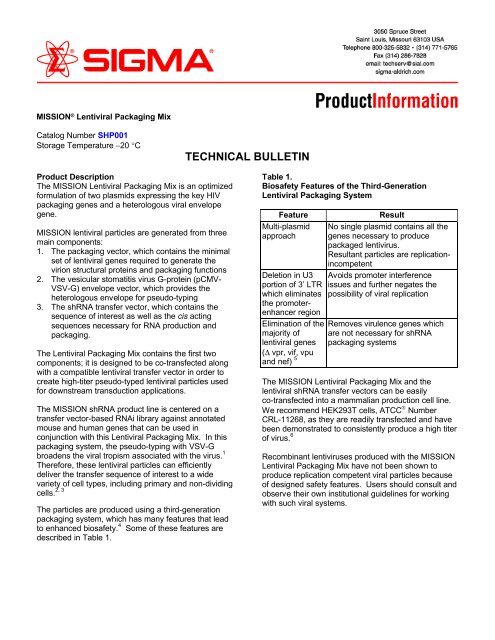
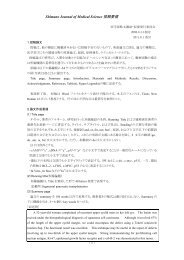
![éèå§äº¢é²çã«å¯¾ããIVR[ PDF: 2.3MB] - å³¶æ ¹å¤§å¦å»å¦é¨](https://img.yumpu.com/47211535/1/190x143/eeaaecaa-3-4-aaivr-pdf-23mb-aae-aa-aa-e.jpg?quality=85)
